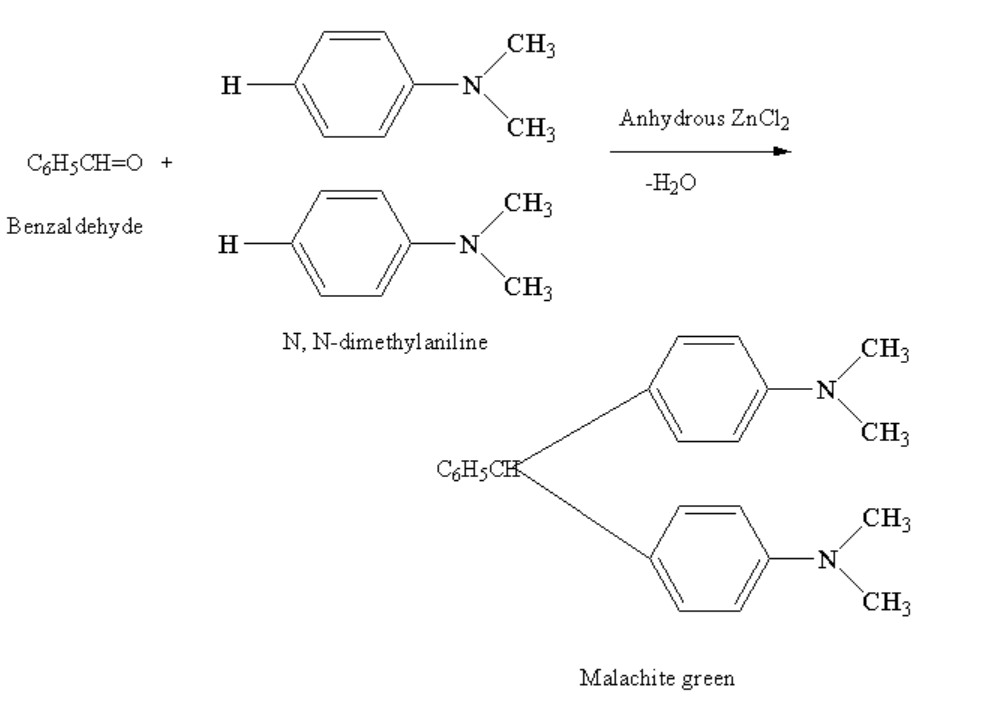
Benzaldehyde condenses with N, N-dimethylaniline in presence of anhydrous \[ZnC{l_2}\] to give
A. Michler’s ketone
B. Azo dye
C. Malachite green
D. Buffer yellow
Answer
224.4k+ views
Hint: The chemical formula of benzaldehyde is \[{C_6}{H_5}CH = O\]. In N, N-dimethylaniline and hydrogen of the amine group are replaced by two methyl groups. In the given reaction dehydration takes place as a water molecule is removed. It is a type of condensation reaction.
Complete Step by Step Solution:
Benzaldehyde in reaction with N,N-dimethyl aniline in presence of anhydrous zinc chloride gives malachite green. Anhydrous means free from water. Here, the two hydrogen atoms from two molecules of N, N-dimethylaniline are removed along with one oxygen atom of benzaldehyde forming a malachite green and removing the water molecule.
The complete reaction between benzaldehyde and N, N-dimethylaniline in presence of anhydrous \[ZnC{l_2}\]is shown below.

Image: Reaction of benzaldehyde and N, N-Dimethylaniline
Therefore, the correct option is C.
Additional information: Hermann Fisher was the first scientist to prepare Leuco malachite green in the year 1877. Malachite green is generally used in the dyestuff industry as triarylmethane and in the pigment industry. The term malachite green is used due to its coloured green cation. Malachite green is very hard to detect as it does not give any fluorescence in an aqueous solution.
Note: It should be noted that two molecules of N, N-dimethylaniline are reacted not one molecule with benzaldehyde to give malachite green. First when benzaldehyde reacts with N, N-dimethylaniline it gives leuco malachite green which is a colourless compound which further on reacting gives hydrogen chloride and oxidation forms malachite green.
Complete Step by Step Solution:
Benzaldehyde in reaction with N,N-dimethyl aniline in presence of anhydrous zinc chloride gives malachite green. Anhydrous means free from water. Here, the two hydrogen atoms from two molecules of N, N-dimethylaniline are removed along with one oxygen atom of benzaldehyde forming a malachite green and removing the water molecule.
The complete reaction between benzaldehyde and N, N-dimethylaniline in presence of anhydrous \[ZnC{l_2}\]is shown below.

Image: Reaction of benzaldehyde and N, N-Dimethylaniline
Therefore, the correct option is C.
Additional information: Hermann Fisher was the first scientist to prepare Leuco malachite green in the year 1877. Malachite green is generally used in the dyestuff industry as triarylmethane and in the pigment industry. The term malachite green is used due to its coloured green cation. Malachite green is very hard to detect as it does not give any fluorescence in an aqueous solution.
Note: It should be noted that two molecules of N, N-dimethylaniline are reacted not one molecule with benzaldehyde to give malachite green. First when benzaldehyde reacts with N, N-dimethylaniline it gives leuco malachite green which is a colourless compound which further on reacting gives hydrogen chloride and oxidation forms malachite green.
Recently Updated Pages
JEE Mains 2026: Exam Dates and City Intimation slip OUT, Registration Open, Syllabus & Eligibility

JEE Main Candidate Login 2026 and Registration Portal | Form Access

JEE Main 2026 Session 1 Correction Window Started: Check Dates, Edit Link & Fees

JEE Isolation, Preparation and Properties of Non-metals Important Concepts and Tips for Exam Preparation

Isoelectronic Definition in Chemistry: Meaning, Examples & Trends

Ionisation Energy and Ionisation Potential Explained

Trending doubts
Understanding Electromagnetic Waves and Their Importance

Half Life of Zero Order Reaction for JEE

Understanding Displacement and Velocity Time Graphs

Understanding How a Current Loop Acts as a Magnetic Dipole

Which of the following will not undergo H V Z reaction class 12 chemistry JEE_Main

JEE Main 2026 Exam Date (OUT): Session 1 and 2 Schedule, Registration and More

Other Pages
JEE Advanced 2026 - Exam Date (Released), Syllabus, Registration, Eligibility, Preparation, and More

JEE Advanced 2026 - Exam Date (Released), Syllabus, Registration, Eligibility, Preparation, and More

CBSE Class 12 Chemistry Question Paper Set 3 2025 with Answers

Understanding Inertial and Non-Inertial Frames of Reference

An alcohol A gives Lucas test within 5 minutes 74 g class 12 chemistry JEE_Main

New Year's Day 2026: Significance, History, and How to Celebrate in India




